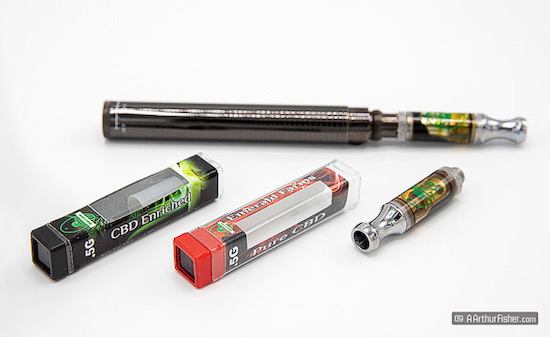Blogs
What's the Vaping Scare About and Why Is It Happening?
Ruth Fisher

What are e-cigarettes?
Electronic cigarettes, or e-cigarettes, are all the rage. Since their introduction in 2003, e-cigarette use (vaping) has mushroomed: as of 2018, more than 10 million people globally vape.
Wikipedia describes an e-cigarette as follows:
An electronic cigarette or e-cigarette is a handheld battery-powered vaporizer that simulates smoking … but without burning tobacco. Using an e-cigarette is known as "vaping" and the user is referred to as a "vaper." Instead of cigarette smoke, the user inhales an aerosol, commonly called vapor.
E-cigarettes, also called vaporizers or vape pens, are used to vape either tobacco or cannabis. Some vaporizers are disposable, while others have reusable pens that take replaceable cartridges containing e-liquid (see Figure 1).
Figure 1: Electronic Cigarette with Cartridges

What is the problem being reported in the news?
According to the CDC, “Between June 28 and September 6, there have been 450 total possible cases of vape-related lung illness,” from which several people have died.[1] This is a nation-wide problem, “linked to multiple illicit market brands across multiple states.”[2]
Health officials are having a difficult time identifying the exact problem causing the illness. Officials know the problem involves tobacco and/or cannabis e-cigarettes, but they don’t know the exact source: “it is unclear what chemical within the e-cigarettes is causing the illness.”[4]
A single case of the illness involved a man who had purchased a cannabis vape from a licensed dispensary.[6] All other cases, however, involved illicit e-cigarettes, that is, vapes purchased off the street, in “pop-up shops,” or by otherwise unlicensed vendors. “The CDC, FDA, and HHS advised consumers Thursday [September 5th] to avoid buying cannabis vapes or using products off the street. They are unregulated, untested, and could be contaminated.”[2],[7]
What do investigators think may be causing the illness?
Officials are focusing on contaminants, adulterants, or counterfeit substances as a likely cause.[4],[7] The problem could be due to chemicals leaching from cartridge containers, chemicals used to add flavor or viscosity to the liquid, chemicals used to dilute (e.g., cut) the e-liquid, or some other contaminant.[7]
Phillip Lamberty, a pulmonologist and critical care specialist at the University of Pittsburgh Medical Center… “My leading [uncorroborated] theory ... is that there has to be some contaminant or series of contaminants that are getting introduced … It is either something new that is happening or there is some contaminant across the board or we have missed other cases that were related.”[4]
More recently, officials have been concentrating on a chemical oil derived from Vitamin E found in nearly all samples as the possible source of the illness.
The oil derived from the vitamin, known as vitamin E acetate, is commonly available as a nutritional supplement and is used in topical skin treatments. It is not known to cause harm when ingested as a vitamin supplement or applied to the skin... but its molecular structure could make it hazardous when inhaled.[6]
Michelle Francl, a chemistry professor at Bryn Mawr College had more to say about Vitamin E acetate, the substance currently under investigation:
Vitamin E acetate is basically grease... Its molecular structure means that “you have to heat it up pretty hot” for it to vaporize. Its boiling point is 363 degrees Fahrenheit, which is well above the 212 degrees F boiling point for water.
Once the oil is heated hot enough to vaporize, it can potentially decompose, and “now you’re breathing in who-knows-what…”
When that vapor cools down in the lungs, it returns to its original state at that temperature and pressure, she said, which means “it has now coated the inside of your lungs with that oil…”[6]
Why do investigators think it’s a new, black market product?
Investigators believe some new “adulterated or contaminated” product is causing the illness because tobacco and cannabis vape products have been on the market for quite some time. Yet, it has only been recently that the lung illness has arisen.
Scott Gottlieb, former head of the FDA, noted, “It’s not like the major manufacturers have suddenly changed their ingredients … It’s probably something new that has been introduced into the market by an illegal manufacturer, either a new flavor or a new way to emulsify T.H.C. that is causing these injuries.”[3]
Why are authorities having such a hard time solving the problem?
Authorities are having a difficult time trying to pinpoint the problem because e-cigarettes have fallen through the regulatory cracks in the system into “a regulatory no man’s land. They are not a food, not a drug, and not a medical device, any of which would have put them immediately in the FDA’s purview. And, until a few years ago, they weren’t even lumped in with tobacco products.” Consequently, billions of dollars worth of e-cigarette products have been sold through the black market as well as through legitimate sources, “online, at big-box retailers and in corner stores without going through the FDA’s rigorous review process to assess their safety.” Furthermore, if e-cigarettes had been regulated, there would have been an established means of tracking and reporting problems or side effects with particular products. Unfortunately, though, this has not been the case:
Because e-cigarettes aren’t classified as drugs or medical devices, which have well-established FDA databases to track adverse events, doctors say there has been no clear way to report and track health problems related to vaping products.
But several lung specialists said that due to the patchwork nature of regulatory oversight over the years, the true scope of the problem is yet to be identified.[5]
Furthermore, while manufacturers may use ingredients that have been ingested in other products, many of those ingredients have not been tested for use in vaping and inhalation into the lungs: “Yet no one knows for sure if you can breathe the same chemicals safely, and many chemicals approved for ingestion become toxic after combustion.”[4]
Next, e-cigarette manufacturers have been treating their formulas as trade secrets, and so many of the ingredients and formulations have not been publicly disclosed. Again, while e-cigarette manufacturers have been using many of the same ingredients as those used in the food flavoring industry, using those same ingredients for vaping and inhalation may be problematic.
Finally, chemicals in the equipment used in vaping pens – metal coils, ceramic elements, or cartridges containing lead packaging – may leach into smokers’ lungs.
Many healthcare industry participants, including Erika Sward, National Assistant Vice President of Advocacy at the American Lung Association, blame the FDA for not regulating the e-cigarette industry sooner. Had they been regulated, Sward argues, then all products would have been tested to ensure they were safe to use:
The fact that e-cigarette have been allowed to be in this unregulated quasi-state for so long is really why we are here now … Because the FDA took forever to assert authority over e-cigs and then delayed the review of each of these products is really at the heart of why we are having this cluster of illnesses.[4]
What should vapers do while all this is being sorted out?
Federal and state officials are urging people to stop using e-cigarettes until the cause of the illnesses has been identified. The CDC and FDA issued a statement warning people who continue to use e-cigarettes to buy them only from licensed retailers, and they “should not modify e-cigarette products or add any substances to these products that are not intended by the manufacturer.”[7]
What conclusions should be drawn from this experience?
Authorities are experiencing tremendous difficulties in trying to pinpoint the exact cause of the current lung illness associated with tobacco and cannabis vaping. These difficulties stem from a confluence of four separate issues:
1. E-cigarettes are new technologies. E-cigarettes are relatively new technologies that employ new forms of substance ingestion into the body, with the potential to adversely affect health. These new products have not been well-studied for their potential to cause harm.
2. E-cigarettes are hybrid products. These new technologies do not clearly fall within the realm of a single market (tobacco, food, drug, medical device). As a result, they have fallen through the cracks of the regulatory system and have been introduced with little regulation or guidance. Furthermore, because they are not being regulated, there is no urgency to study potential dangers associated with the use of e-cigarettes.
3. E-cigarette manufacture and supply lack transparency. E-cigarette technology is quickly evolving, and details of its manufacture and makeup have been obscured by trade secrets and black market activity. There is thus a substantial lack of transparency in e-cigarette manufacturing materials and product ingredients.
4. Use of E-cigarettes has exploded. The fantastic popularity of e-cigarettes by users has attracted a large multitude of suppliers. Vendors have blanketed the market with products through every possible legal and black-market venue.
These four separate issues — a new technology that has fallen through the regulatory cracks, suffered a lack of transparency in operations, and been subject to frenzied activity — have created a perfect storm that’s preventing authorities from quickly discovering the root of the problem.
Based on the current experience with e-cigarettes, it would be easy to conclude that before any new product may be introduced to the market, it should be subject to examination for potential harm, and if potential for harm is found to exist, then the product should be regulated. However, this type of rule would have two large disadvantages. First, it would quickly slow to a trickle the introduction of new products into society. And second, the cost of undergoing pre-market examination and obtaining approval would cause the price of any new product deemed acceptable to significantly increase.
This case provides an excellent example of how the freedom to enter a market yields both tremendous opportunity and variety for consumers, as well as tremendous risk.
References
[1] (2019, September 6?). Mysterious vaping illnesses are causing life-threatening lung injuries and death. Here’s what we know about the people who have been affected so far. Insider. https://www.insider.com/vaping-has-caused-lung-injuries-death-in-all-these-people-2019-9
[2] Downs, David (2019, September 6). Vape Pen Lung Disease: Here’s What You Need to Know. Leafly. https://www.leafly.com/news/health/vape-pen-lung-disease-advice-consumers
[3] Kaplan, Sheila (2019, August 30). Don’t Use Bootleg or Street Vaping Products, C.D.C. Warns. NYT. https://www.nytimes.com/2019/08/30/health/vaping-e-cigarettes-marijuana-cdc.html
[4] Karlis, Nicole (2019, September 4). Experts say a lack of regulation led to mysterious vaping illness. Salon. https://www.salon.com/2019/09/03/experts-say-a-lack-of-regulation-caused-mysterious-vaping-illness/
[5] Lupkin, Sydney and Anna Maria Barry-Jester (2019, August 27). Investigators Rush to Trace Vaping Products Linked to Outbreak. Kaiser Health News. https://www.thedailybeast.com/
[6] Sun, Lena H. (2019, September 5). Contaminants found in marijuana vaping products linked to deadly lung illnesses, tests show. The Washington Post. https://www.washingtonpost.com/health/2019/09/05/contaminant-found-vaping-products-linked-deadly-lung-illnesses-state-federal-labs-show/
[7] Sun, Lena H. and Laurie McGinley (2019, August 30). As vaping-related lung illnesses spike, investigators eye contaminants. The Washington Post. https://www.washingtonpost.com/health/as-vaping-related-lung-illnes...08/29/cfe26032-ca78-11e9-be05-f76ac4ec618c_story.html?noredirect=on

